Our test lab received the Garlyn L600 coffee machine. Like most devices of this brand, it has a modern and stylish design. Now we have to find out how well it copes with making coffee during testing.
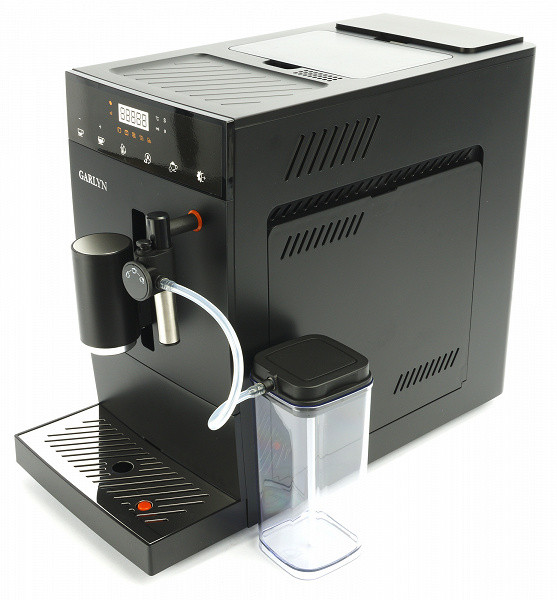
It is no secret that many models, although released under different brands, have the same filling, and sometimes it turns out to be not the best. We could not immediately remember any analogues of the Garlyn L600 coffee machine, so we approached the testing with great interest.
Characteristics
| Manufacturer | Garlyn |
|---|---|
| Model | L600 |
| Type | automatic coffee machine |
| Country of origin | China |
| Guarantee | 1 year |
| Service life * | 3 years |
| Declared power | 1100-1350 W |
| Body material | plastic, metal |
| Color | black/metallic |
| Water tank capacity | 1.2 l |
| Type of cappuccino maker | automatic, external tank 0.4 l |
| Type of coffee used | cereal |
| Built-in coffee grinder | Yes |
| Capacity of the grain tank | 1300 g |
| Number of grinding degrees | 5 |
| Pressure | 20 bar |
| Control | electronic, sensory |
| Weight | 7.7 kg |
| Dimensions (W×H×D) | 189×315×390 mm |
* Contrary to popular belief, this is not a period after which the device will necessarily break down. However, after this period, the manufacturer ceases to bear any responsibility for its functionality and has the right to refuse to repair it, even for a fee.
Equipment
The coffee machine came for testing in two packages. On the outside there was a strong cardboard box with the brand name, model and a schematic image of the device. Inside we found bright packaging in orange and black colors. On a black background there is a photo of the machine and the main characteristics of the model. The side edges are decorated with icons emphasizing the key advantages of the device, color photos and a detailed list of technical data. All this looks very stylish and attractive, especially if you leave the «gift» ribbon.
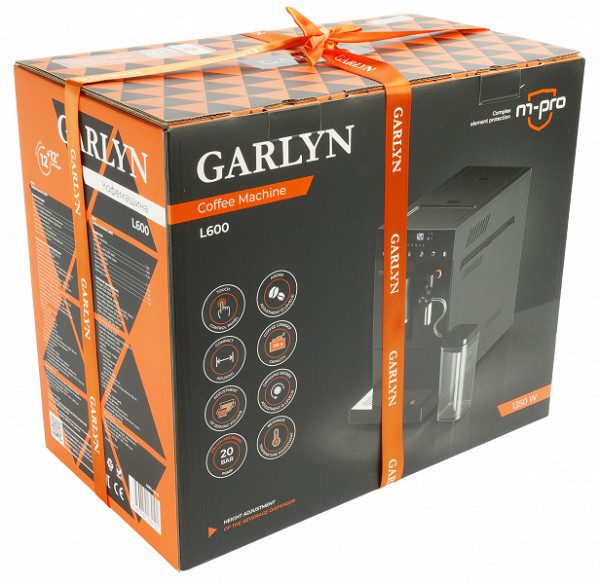
The contents were neatly packed in plastic bags and protected from impacts by foam inserts.
After opening the box, we found:
- the coffee machine itself, including a removable drip tray and a water tank
- a frother and a hose for it
- two brushes for cleaning the device
- a set of seals
- a service book and an operating manual (plus a small cheat sheet)
As for the package, the manufacturer did not add anything extra or unnecessary.
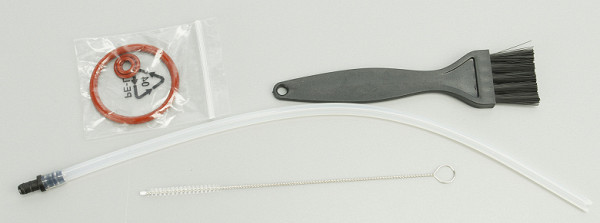
At first glance
At first glance, the Garlyn L600 makes an exceptionally positive impression. All elements look strict, stylish and well-thought-out. During a quick visual inspection, we were unable to find a single element that looked foreign or of poor quality. Let's now take a closer look at the coffee machine and highlight its main features.
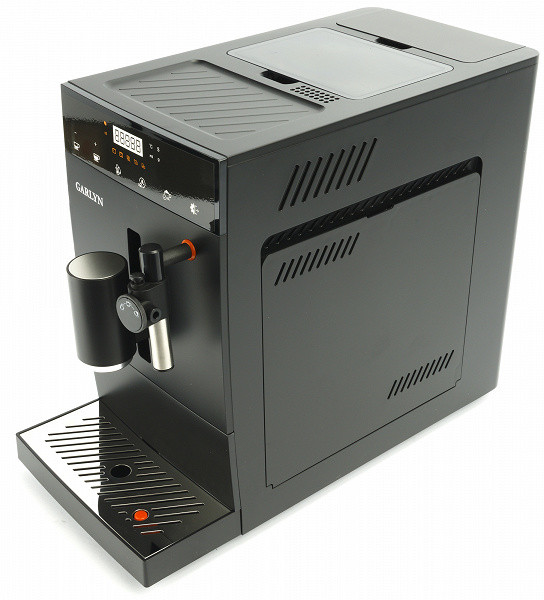
First, let's pay attention to the case. It is made of black matte plastic, and additionally metal elements and orange design accents are used, which immediately gives away its belonging to Garlyn products.
On the back side there is a sticker with the model number, as well as an outlet for connecting the power cord. There is also a water supply connector here, equipped with a simple metal mesh filter.
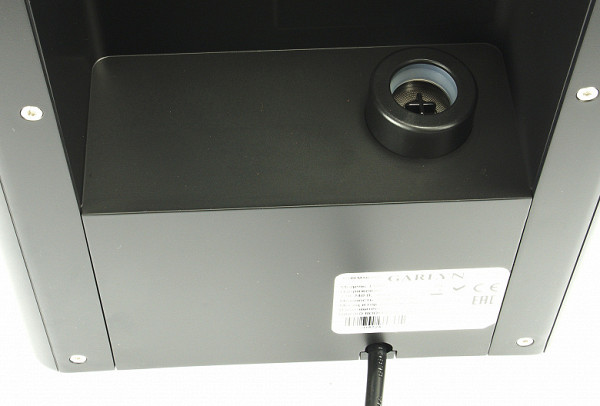
And this is what the back of the coffee maker looks like with the water tank installed.
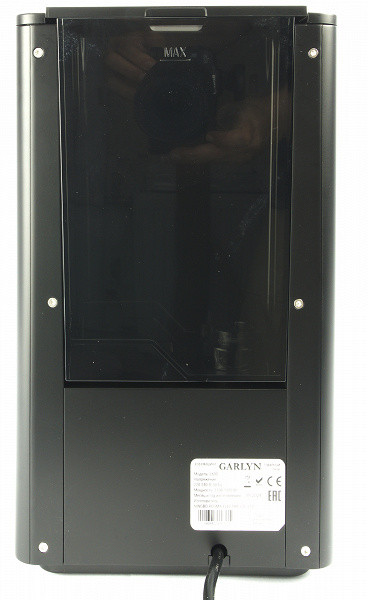
On the right side there is a hatch under which the brewing unit is hidden, and next to it there are many holes for ventilation.
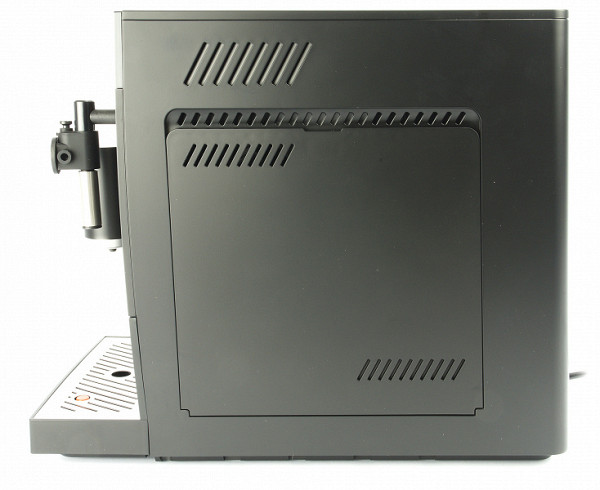
It is worth noting that the hatch is completely removable and is fixed in place with magnets. In our opinion, this is a very convenient and practical solution, which is tactilely more pleasant than traditional mechanical hinges and latches.
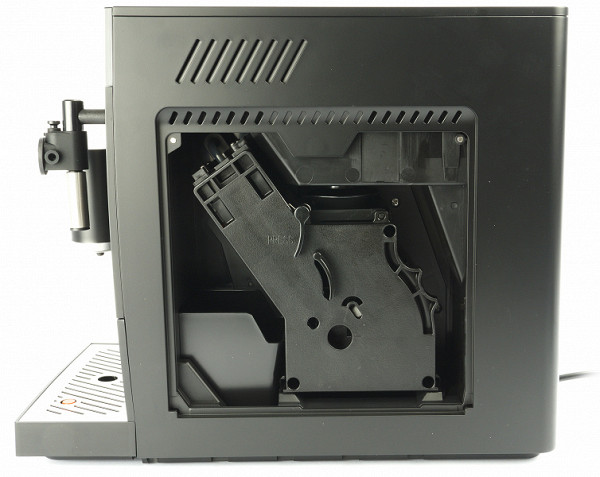
Let's pay attention to the brewing unit. In our coffee machine it is removable and requires regular maintenance, as in all automatic models with a similar design. Although the design of the unit is fairly standard, each manufacturer is forced to develop its own unique version due to patent restrictions in order to avoid accusations of copying.
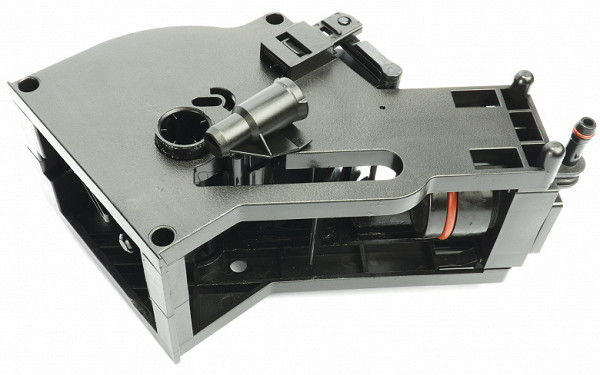
We did not find any markings on the brewing unit, which makes it difficult to characterize it and determine its belonging to a certain «family». It can be noted that the unit is completely removed, and upon inspection we noticed that it was generously lubricated with food-grade silicone.
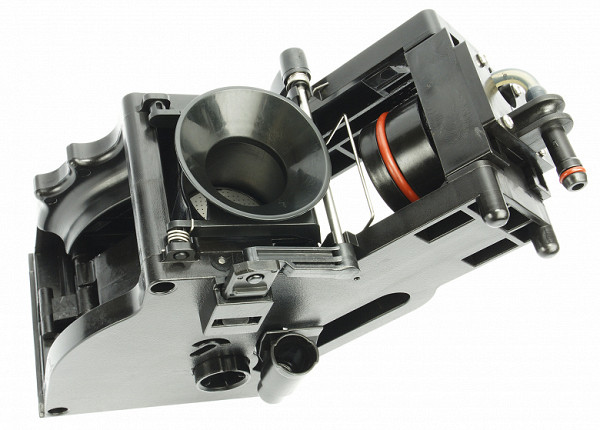
The filter of the brewing device is metal.
The left wall of the coffee maker's body is smooth. Here our attention is attracted, perhaps, only by the device's power button.
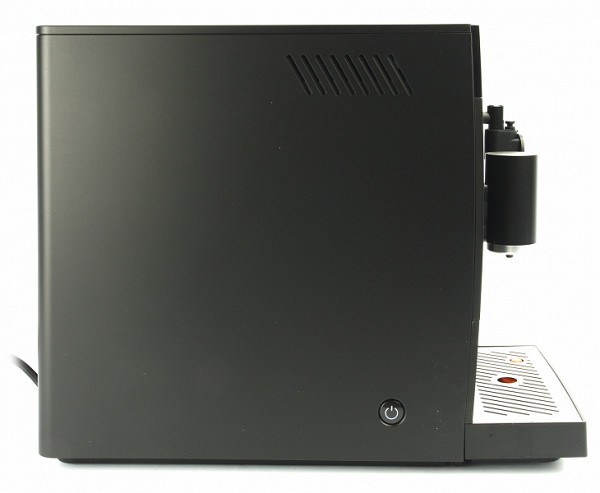
At the front we see a single cup dispenser with adjustable height.
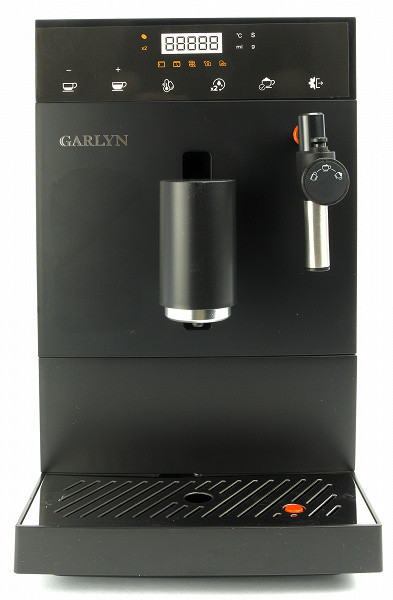
In the lower position, the distance from the spout to the stand is 7.5 cm, in the upper position — 14 cm.
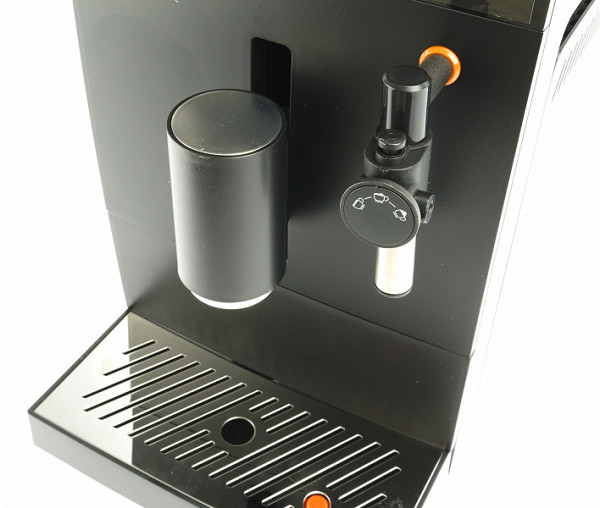
While the drink is being prepared, the area under the spout (cup) starts to light up automatically using an LED.
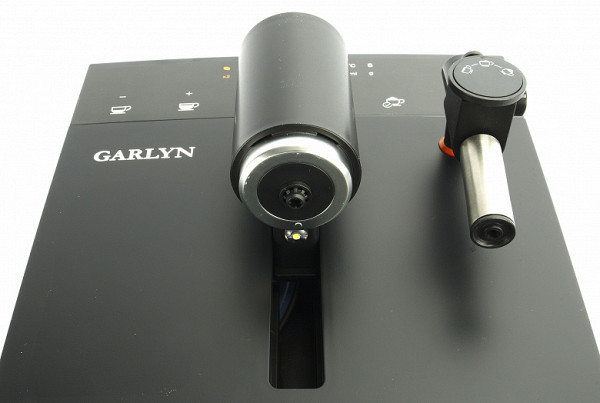
On the right is a milk frother, which at first glance resembles a regular hand-held cappuccino maker, but this impression is deceptive: an external milk jug is connected here.
The milk jug tube is removable and requires regular cleaning, and the frother module has a wheel for adjusting the intensity of the milk froth. This is perhaps the only element of the coffee maker that does not seem very reliable. We would have liked to see a durable plastic handle instead of a miniature rubber wheel.
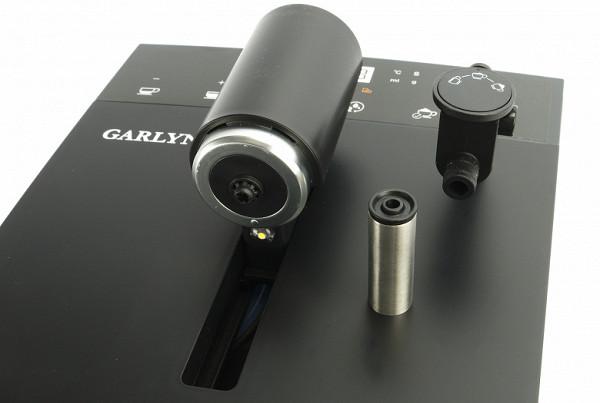
The jug is made of transparent plastic and has a plastic lid. Milk is fed through a special tube and enters the coffee machine through a flexible hose. The jug capacity is 400 ml.
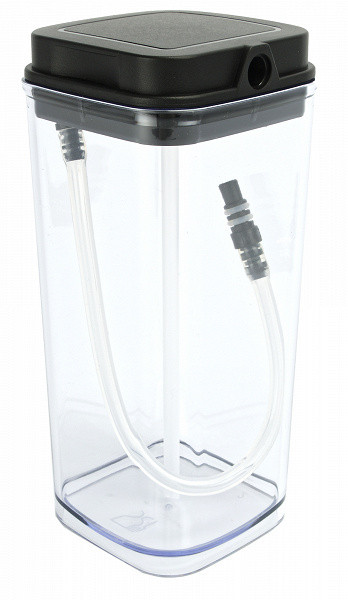
At the bottom of the coffee machine, as usual, there is a drip tray and a compartment for used coffee tablets.
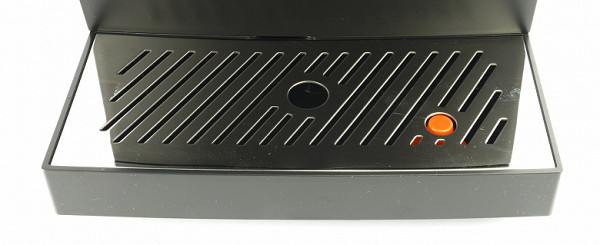
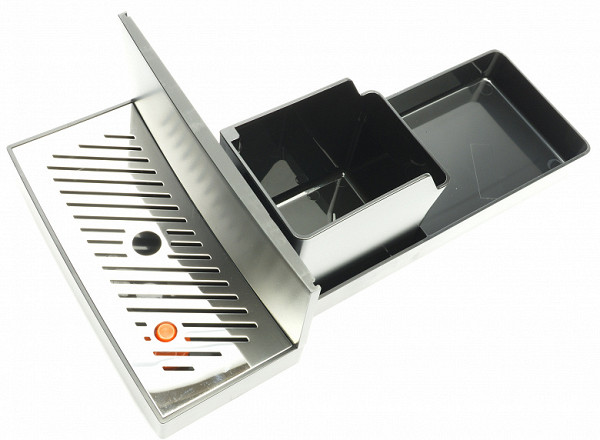
The tray is made of plastic and has a small volume. The overflow sensor is presented in the form of a classic float. The cup stand is metal and glossy, which makes it susceptible to scratches. The plastic compartment for used tablets holds about 10 servings of coffee. The appearance and shape are standard.
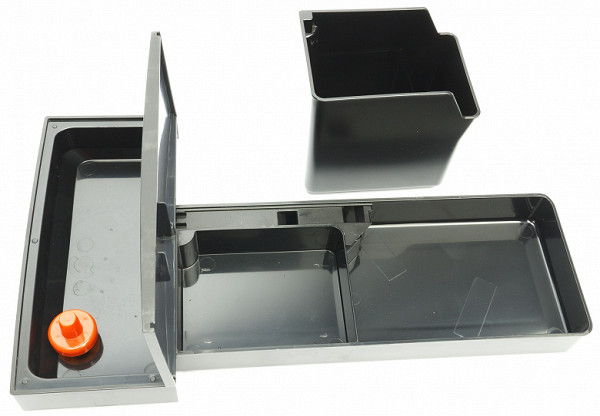
On the top of the coffee machine are the bean compartment lids, made of translucent plastic, and the black plastic water tank lid, which also serves as a handle for carrying the container. The front part has a cup warmer.
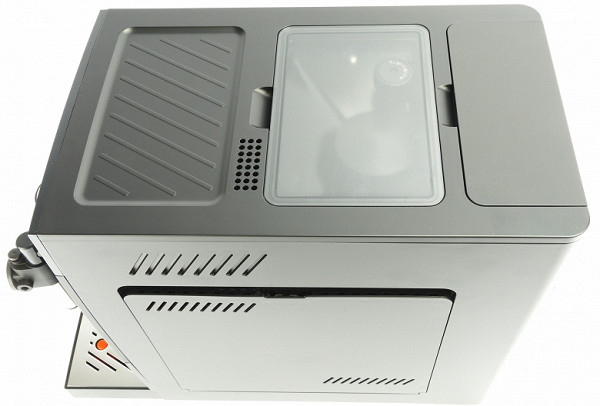
The bean compartment cover is easily removed, providing access to the coffee grinder. On the back of the cover there is a rubber seal, which helps reduce noise, as the coffee grinder can work quite loudly, which can be unpleasant for households. In addition, such a seal reduces the likelihood of airing of already poured coffee.
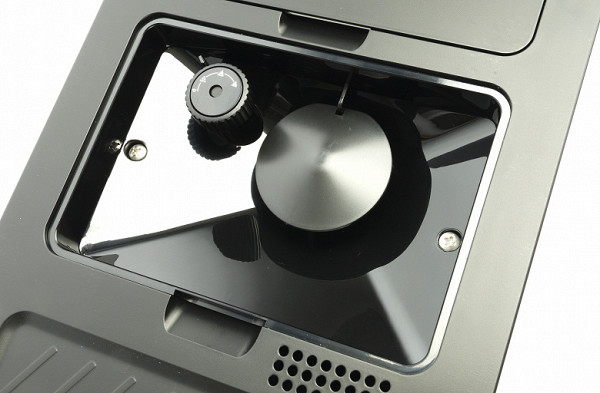
Let's look at the coffee grinder. It looks quite simple from the outside, but if you look inside, you can assume that this is a coffee grinder with steel conical millstones with a diameter of about 40 mm — a typical option.
The degree of grinding is adjusted using a handle with five fixed positions, but smooth adjustment is not provided. There are no shafts for using ground coffee in this model, but this is not a serious drawback — it is unlikely that anyone will buy a grain coffee machine and decide to use ground coffee. The capacity of the grain compartment is only 130 grams.
The water container is made in a standard design.
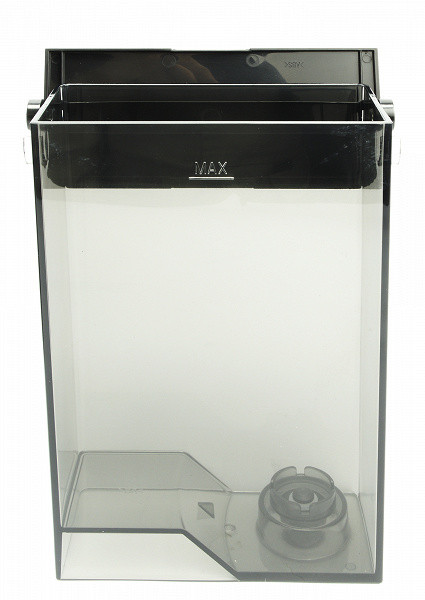
The lid of the water container turns into a handle when removed, which makes it easy to take the container out of its niche. Thanks to this handle, the transparent plastic container is easy to carry with one hand and return to its place. Although the instructions prohibit pouring water into the installed container, it is very convenient to do so due to the hinged lid.
There is a maximum water level mark on the top of the container, and its volume is 1.2 liters.
Now about the control panel: it is located at the top of the coffee machine and consists of touch buttons and LED indicators. To make it easier for the user to understand the functions, the manufacturer has pasted a paper sticker on the panel with an image of all possible symbols, which will also protect the glossy surface from scratches.

When switched off, neither buttons nor indicators are visible.
Instructions
The user manual is in the format of a small brochure, printed on high-quality glossy paper with black and white printing. The information is presented in an accessible language, and the thoughtfulness in both the design and the careful presentation of the materials is noticeable.
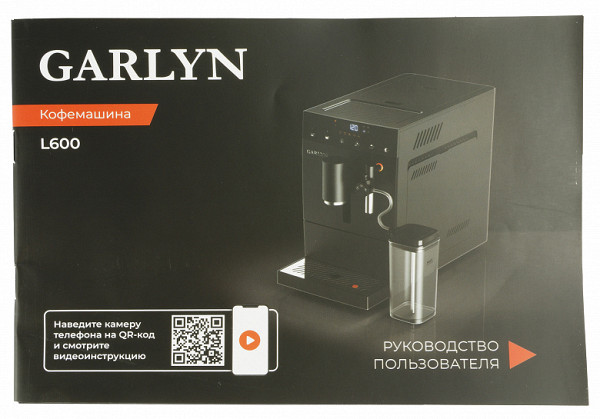
All actions and operations that you will encounter are accompanied by visual illustrations. Such instructions are pleasant not only to hold in your hands, but also to study, because you can feel the care for the user.
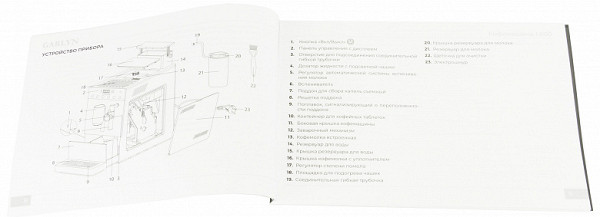
Additionally, in the box we found a small cheat sheet, having studied which you can get a general idea of how to use the coffee maker, even without studying the instructions.
Control
As already noted, the coffee machine is controlled via backlit touch buttons and LED indicators. They not only display information about current processes, but also signal the user if attention is needed or if any problems arise.
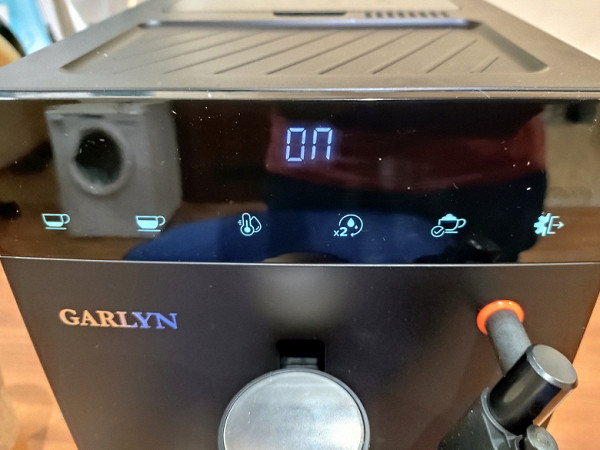
The bottom row contains the following buttons:
- for making espresso
- for making Americano
- for dispensing hot water
The «Functions» button activates the preparation of a drink for two cups with a short press, and with a long press (3 seconds) starts the self-cleaning process of the coffee machine.
The «Milk foam/Confirmation» button allows you to start making milk foam with a short press in standby mode, and in the settings menu confirms the selected parameters.
The «Settings/Stop» button stops the preparation process with a short press, and with a long press opens the settings menu. In the menu, a short press switches the parameters.
The indicators signal the following situations:
- no coffee beans
- two-cup brewing mode is on
- side lid is not closed or installed incorrectly
- water in the tank is out or the tank is installed incorrectly
- it's time to descale the coffee machine
- brewing unit is not installed or installed incorrectly
There is a digital display on top, with which you can:
- set the volume of ground coffee for espresso (from 7 to 12 grams)
- set the volume of water (starting with 20 ml in 5 ml increments)
- set the volume of water for Americano (from 20 to 250 ml, default 80 ml)
- set the amount of milk foam (in seconds) from 15 to 60 seconds in 5 second increments
- set the brewing temperature (from 75 to 95°C in 5 degree increments)
- set the automatic switch-off time (from 1 to 24 hours or never)
Changes can be made to the built-in recipes (espresso, americano, milk foam and hot water) by going to the settings menu.
It is also possible to make changes directly during the preparation of the drink: the coffee grinder is running — you can adjust the volume of ground coffee; espresso preparation has started — you can increase or decrease the volume. This makes the preparation process simple and convenient. If the espresso is too thin, you can easily adjust the volume of water or the number of beans without having to go to the menu. There is also a function to return to factory settings.
The automatic milk frothing system regulator allows you to adjust the fluffiness of the milk foam by turning it left and right. The far right position corresponds to the minimum fluffiness, in this case only hot milk will be supplied to the mug.
Operation
The first thing to do after connecting the coffee machine to the network is to fill the tank with fresh water, turn on the device and wait for its initial pouring.
After the first start, we recommend making a couple of servings of coffee to additionally flush the system and get rid of possible foreign odors.
What did you like about the control system? The coffee machine always informs the user about the current process. For example, if it is preparing for work, a scale of stripes fills up on the display. When the cappuccino maker is warming up, we see a countdown, and during the preparation of espresso, the amount of coffee and the volume of water are displayed.
It is especially pleasing that the developer respects users and shows the real state of affairs. If we turn off the preheated machine and then turn it on again, the screen will show that almost all the stripes are lit, and there is very little time left to wait. The same applies to the warming up of the cappuccino maker: the initial numbers of the countdown depend on the time required for warming up.
However, there are also shortcomings. The sensor for the absence of coffee beans does not stop the preparation of the drink. This means that we can start espresso even without coffee, which can lead to an unpleasant situation, especially considering the small bean compartment.
If the water runs out during the espresso preparation process, the machine will pause and continue only after filling the tank. This, of course, will negatively affect the quality of the finished drink.
Now let's briefly review the main elements of the coffee machine again and highlight their characteristic features.
Water container
The 1.2-liter water container is located at the back and is removed from the top. It can be easily removed and installed with one hand. The lid of the container is hinged, which allows you to pour water from above. The instructions do not prohibit pouring water into the installed container, so you can try this, but you should be careful not to spill. The water inlet valve to the coffee machine is equipped with a simple metal filter.
Brewing unit
The compact brewing unit is hidden behind the side hatch. It requires periodic removal and cleaning. The unit is removed and installed using a latch.
Pump
According to the instructions, the coffee machine is equipped with a pump with a pressure of 20 bars. However, this is more of a marketing ploy: for making espresso, the pressure will be about 9 bars, and the remaining «bars» are essentially not needed.
Thermoblock
Although we cannot verify this without disassembling the coffee machine, by studying the information about the device, we can assume with a high degree of certainty that our device is equipped with a flow-through thermoblock with a power of up to 1350 W.
Cappuccino maker
Our coffee machine has an automatic cappuccino maker, which uses an external plastic jug with a capacity of 0.4 liters, connected with a flexible hose. If the jug is not needed, it can be easily detached and put in the refrigerator, which contributes to longer storage of milk. The volume of milk foam is adjusted programmatically, and the intensity of foaming is mechanically adjusted with a rotary switch.
Coffee grinder
The coffee machine has a burr grinder with conical steel burrs, allowing you to choose one of five grinding degrees. Adjustment is done manually using a special wheel. It is important to remember that you should only change the grinding degree when the coffee grinder is running, otherwise it may damage it. You can evaluate the results of the changes only after making 2-3 cups of coffee.
Compartment for used coffee and drips
The grounds container holds about 10 servings and is removed from the front along with the drip tray. The tray is small, so you need to empty the water more often than in full-size coffee machines. However, if you remember to place an empty cup under the dispenser when you turn it on, the amount of drips in the tray will be significantly reduced.
The container full indicator works on a counter basis. This means that if you empty the tray when the machine is turned off, it will not register this and may signal the need to empty the container ahead of time.
Care
In most cases, the coffee machine notifies the user of the necessary actions.
Maintenance of the device includes the following procedures:
- emptying and rinsing the drip tray as needed;
- emptying and cleaning the coffee grounds container when filling or if the coffee machine will not be used for a long time;
- rinsing the clean water tank;
- cleaning the brewing mechanism and removing coffee residues with a brush;
- rinsing the milk supply pipe and connecting elements (valves, seals, etc.), it is recommended to do this after each preparation of milk foam;
- cleaning the automatic milk frothing system: pouring water (instead of milk), disassembling the frother and rinsing its parts.
Descale the coffee machine as needed or when prompted. The body can be wiped with a soft, damp cloth.
All information on keeping the device clean is contained in the instructions, so we will not bore the reader with details.
Overall, the coffee machine was fairly easy to maintain. The only tricky part was the milk frother. Even though making milk drinks is easy, we weren't always willing to clean the valve, milk tank, and connecting tubes for the sake of one morning cappuccino.
Our measurements
During the testing of coffee machines, we found that the number of parameters to be measured is not that large. This is explained by the fact that the coffee preparation process is fully automated, and the user is allowed to intervene only at certain moments, such as setting the volume of water, changing the degree of grinding and turning on or off pre-wetting.
However, we measured some parameters that will help to better understand the capabilities of the device.
The maximum power consumption we recorded was 1120 W. In standby mode, the coffee machine consumes 0.3 W, and in active mode — about 3-4 W.
The initial switch-on (heating) of the machine takes 1 minute, including the time required to pour a small amount of water.
We consider the power consumption when preparing drinks to be insignificant: when preparing several milk drinks and five portions of espresso, as well as two pours of hot water, the wattmeter showed about 0.25 kW h.
Making any standard drink (without milk) takes about 2 minutes from the moment the coffee machine is turned on.
We also measured the noise level at a distance of 1 meter from the device. When pouring water, the coffee machine creates noise up to 62 dBA, and when the coffee grinder is working — up to 72 dBA. These values are within the normal range and do not differ much from the average. Good sound insulation of the coffee grinder also deserves praise thanks to a special sealing gasket on the lid of the bean compartment.
The temperature of the finished drinks turned out to be standard: when setting the 90 °C mode, hot water begins to flow into the cup at a temperature of 84 °C, but by the end of pouring 250 ml it drops to 77 °C (with a large volume of water, the heating does not have time to reach high values). The temperature of milk drinks (espresso with milk foam) is a comfortable 60-62 °C. The temperature of 25 ml espresso in an unheated cup was 73 °C, and Americano — 78 °C.
Practice tests
During the testing, we prepared drinks from the list of built-in programs and checked the operation of the cappuccino maker. We rated the quality of all drinks as above average, although we still have some comments.
Espresso
The classic brewing method in our machine is done with one push of a button. First, we set the operating temperature to 90 °C and tried to make the strongest drink possible. To do this, we selected 12 grams of beans in the settings and set the water volume to 25 ml, expecting to get a standard ratio of 1:2 — 1 gram of beans per 2 grams of drink.
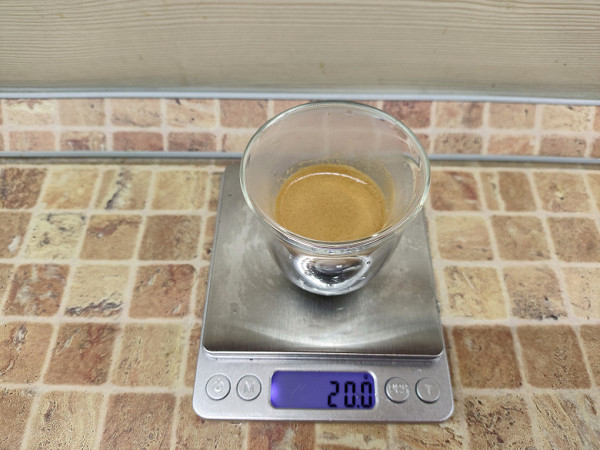
We start the brewing process… and get 20 grams of the drink! This is an excellent result, and a small correction can be made by changing the grind or the volume of water supplied.
A pleasant foam of crema formed on the surface of the espresso. We subjectively evaluate the strength and richness of the finished coffee as very decent. The drink turned out strong, without acidity and bitterness — a real espresso, almost the same as the owners of horn coffee makers prefer.
The temperature of the drink in an unheated cup was 73 °C, which is also considered a good result.
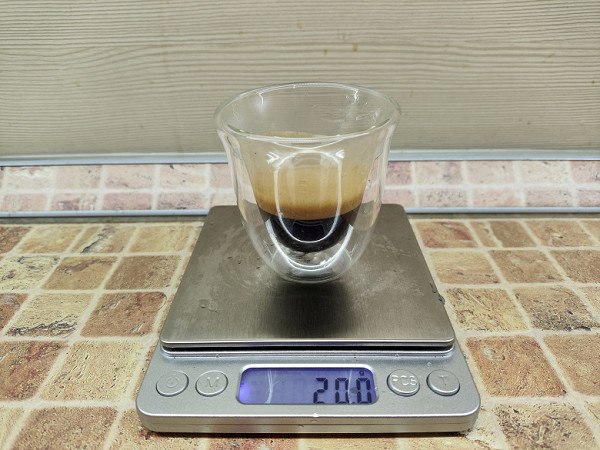
Those who prefer a less strong “espresso” (we put this name in quotation marks here, since it is more correct to call this drink “lungo”) can reduce the portion of coffee or increase the amount of water.
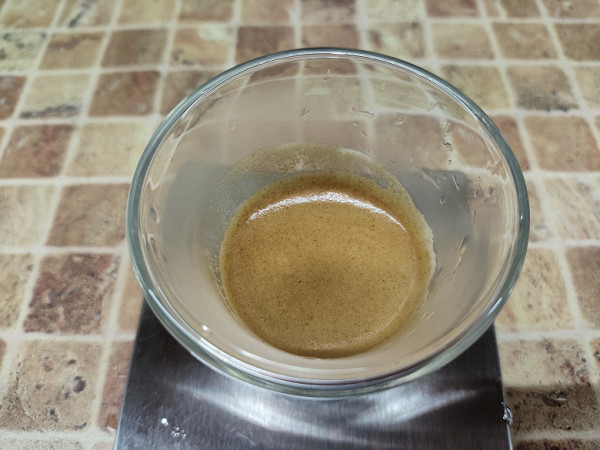
The used coffee tablet looks dry and crumbly, with a minimum moisture content.
To check this, we took a dried tablet and weighed it. The scale showed 11 grams, which confirms the 12 grams declared by the developer. We had almost the finest grind set, which gives a small reserve — by changing it, you can reach 12 grams.
Result: excellent
Americano
The coffee machine prepares Americano by adding hot water to espresso, which is the correct approach.
By default, 80 ml of hot water is supplied, and the temperature of the finished drink is about 78 degrees.
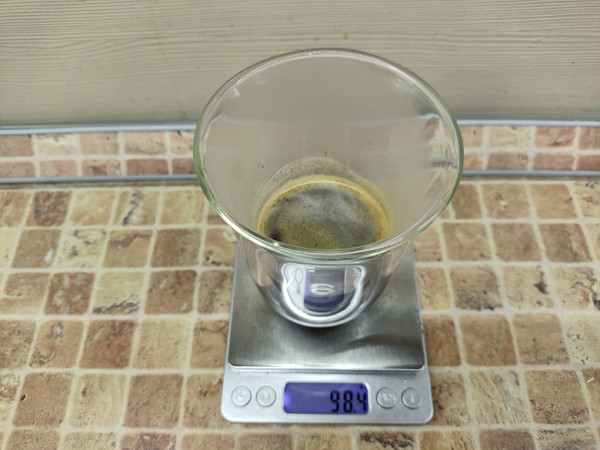
What can we say about the taste of Americano? Since our coffee machine makes good espresso, the Americano turns out correct and tasty.
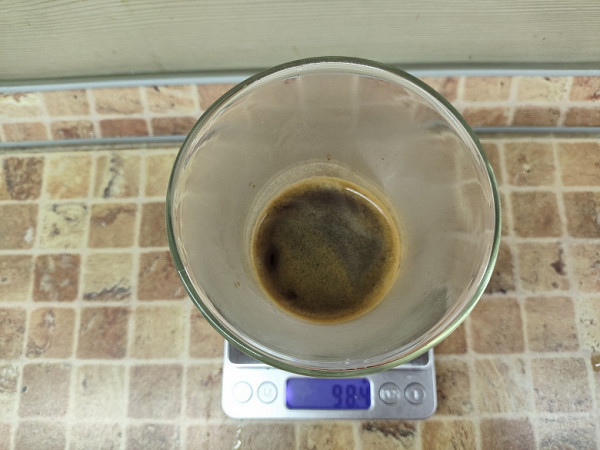
Naturally, if desired, we can adjust the volume of water to achieve the most suitable taste, in accordance with our own wishes.
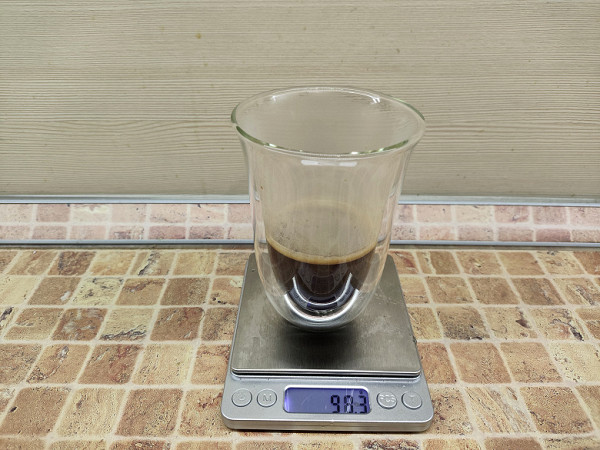
Result: excellent
Milk drinks
Our coffee machine does not make milk drinks at the touch of a button. You have to make an espresso first, and then separately dispense milk foam. This allows you to make cappuccino or latte, as well as just hot milk.
The first time we made milk foam in the maximum foaming mode, we were disappointed with the result — we saw a lot of splashes.
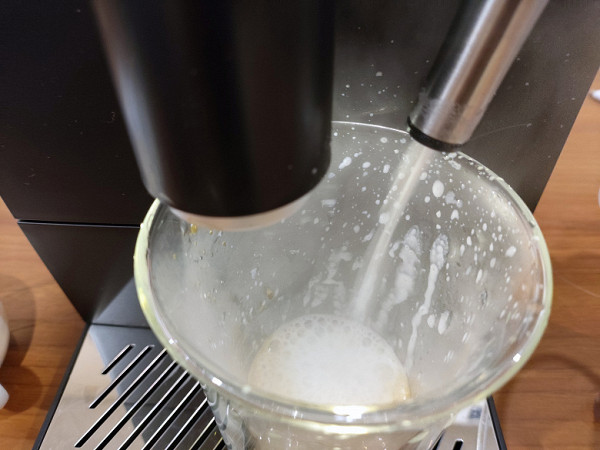
The quality of the foam was mediocre.
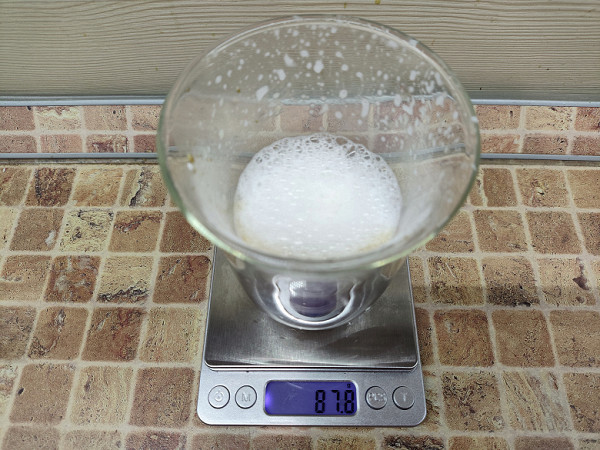
We move the cappuccino maker regulator to the middle position and the result changes dramatically.
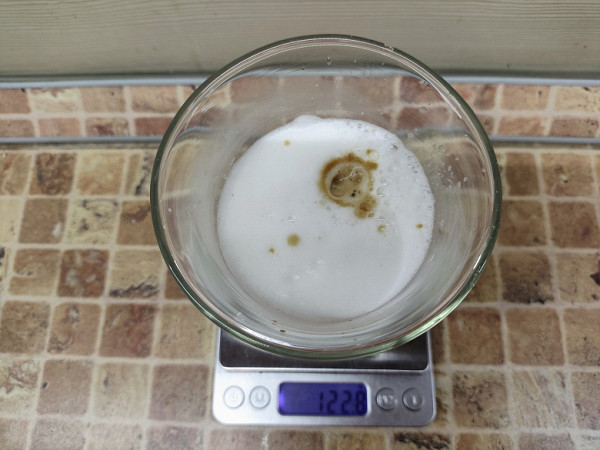
The foam gets rid of large bubbles, becomes fluffy and stays well in the finished drink, without settling.
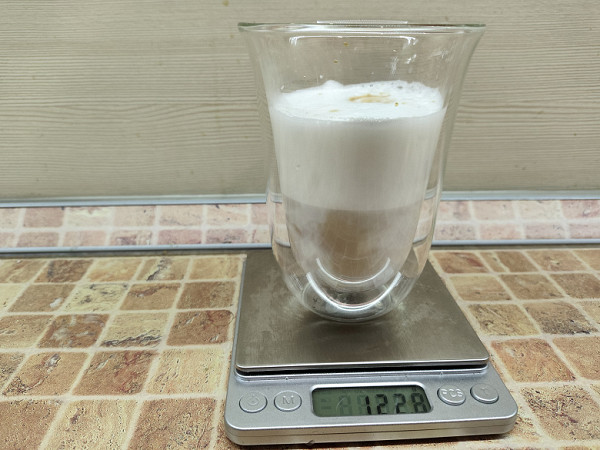
The volume of milk foam is adjustable, so we can get the most suitable ratio of milk and coffee. The temperature of the finished drink will be 57-59 degrees — you can drink it right away.
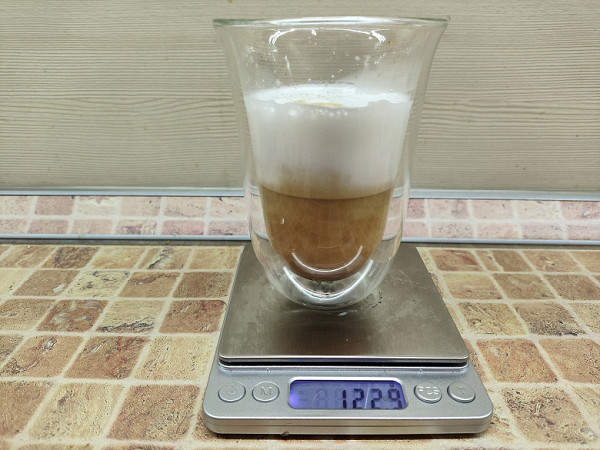
Thus, we rate the result as excellent again. Our simple cappuccino maker coped with the task and overall pleased us.
Result: excellent
Conclusions
The Garlyn L600 coffee machine has proven to be a surprisingly successful model. It is not a fully automatic device, as the milk froth preparation must be started manually, which makes it impossible to get a cappuccino “at the touch of a button”. However, it makes an excellent espresso (and therefore an Americano) and produces high-quality milk froth. So if you do not plan to make milk drinks often, this will not be a serious problem.
Milk is supplied from an external reservoir and is frothed automatically, but you will have to clean the system manually by adding water and cleaning the removable milk frothing module.
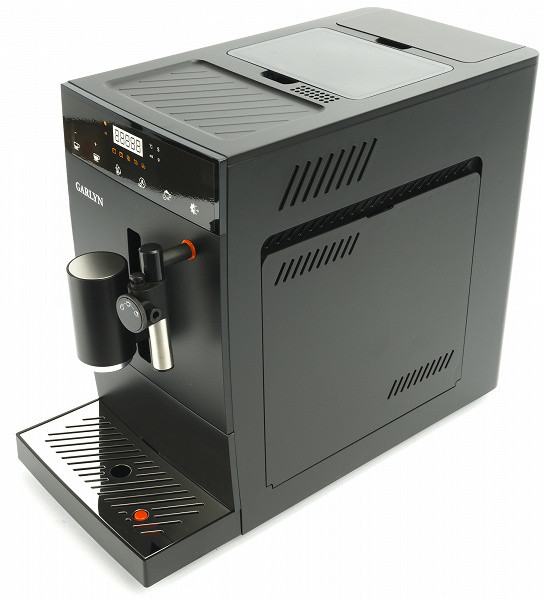
The undoubted advantages of the Garlyn L600 include the ability to fine-tune the temperature and a fairly capacious brewing unit (up to 12 grams of coffee), which allows you to make real strong espresso and other drinks based on it.
It is also worth noting the convenient and comfortable control panel, thanks to which using the coffee machine is not only easy, but also pleasant.
As for the disadvantages, first of all, this is the lack of precise adjustment of the degree of grinding. There are only 5 settings for the coffee grinder, while it would be desirable to have at least 7-8, or better yet, smooth adjustment (which is typical for more expensive models).
In addition, the volume of the grain container and water tank is not too large, so they will need to be filled quite often. The water tray of this model also fills up quickly. Thus, the coffee machine is best suited for those who drink 1-2 cups of coffee a day. If your family drinks coffee all the time, it will take a lot of time to maintain the appliance: you will need to regularly add beans, add water, empty the tray and throw away the used coffee.
Overall, in our opinion, the model turned out to be successful due to the fact that the coffee turns out very tasty.
Pros:
- automatic external cappuccino maker
- customizable programs for espresso, americano and milk foam
- small size of the device
Cons:
- I would like even finer grind adjustment
